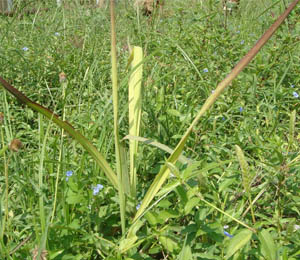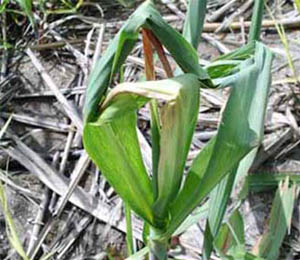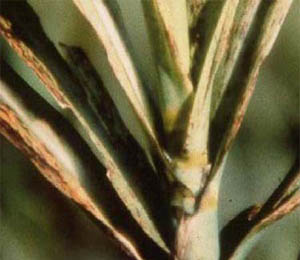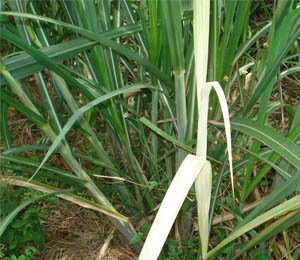Sugarcane (Saccharum officinarum) family Gramineae (Poaceae) is widely grown crop in India. Broadly there are two distinct agro-climatic regions of sugarcane cultivation in India, viz., tropical and subtropical. Heavy soils with good drainage are preferred for sugarcane cultivation, though it grows well on medium & light-textured soils also with assured irrigation. Soils with 0.5- 0.6 % carbon content & pH 6.5 to 7.5 are most suitable for sugarcane growth.

 All leaves of sugarcane exhibit a yellow – green colour.
All leaves of sugarcane exhibit a yellow – green colour.
 Die back of older leaves
Die back of older leaves

 Colour of the leaves in greenish blue or red - purple discolouration on tips and margins, narrow and somewhat reduce in length.
Colour of the leaves in greenish blue or red - purple discolouration on tips and margins, narrow and somewhat reduce in length.
 Reduction in length of sugarcane stalks, diameters of which taper rapidly at growing points.
Reduction in length of sugarcane stalks, diameters of which taper rapidly at growing points.

 Depressed growth Yellowing and marginal drying of older leaves
Depressed growth Yellowing and marginal drying of older leaves

 Minute chlorotic spots with dead centers which later become dark reddish-brown.
Minute chlorotic spots with dead centers which later become dark reddish-brown.
 Plants weak with thin stalks and soft rid.
Plants weak with thin stalks and soft rid.

 Young leaves are light green or yellowish-green with smaller chlorotic spots that become dark brown.
Young leaves are light green or yellowish-green with smaller chlorotic spots that become dark brown.
 Rusty or freckled appearance spotting pronounced on the older leaves.
Rusty or freckled appearance spotting pronounced on the older leaves.

 Plants have an off-color or yellowish-green appearance like N deficiency the youngest leaves are more chlorotic.
Plants have an off-color or yellowish-green appearance like N deficiency the youngest leaves are more chlorotic.
 Stalks short thin and leaf area reduced.
Stalks short thin and leaf area reduced.

 Leaves become smaller; malformed leaves.
Leaves become smaller; malformed leaves.

 Symptoms occur in young leaves; leaves become yellow in color with smaller in size.
Symptoms occur in young leaves; leaves become yellow in color with smaller in size.

 Young leaves where pale stripes with scanty chlorophyll content occur between parallel lines.
Young leaves where pale stripes with scanty chlorophyll content occur between parallel lines.
 Leaves turn completely white, even in the veins and midribs.
Leaves turn completely white, even in the veins and midribs.

 A chlorosis in young leaves increases to a uniform yellow a gray metallic purplish Upward curving of blade margins.
A chlorosis in young leaves increases to a uniform yellow a gray metallic purplish Upward curving of blade margins.
 luster develops on the appear surface.
luster develops on the appear surface.

 Pitting develops along the veins.
Pitting develops along the veins.

 Light greening or yellowing first appears in younger leaves followed by pitting, collapse Drying of interveinal tissue, leaving the veins green
Light greening or yellowing first appears in younger leaves followed by pitting, collapse Drying of interveinal tissue, leaving the veins green